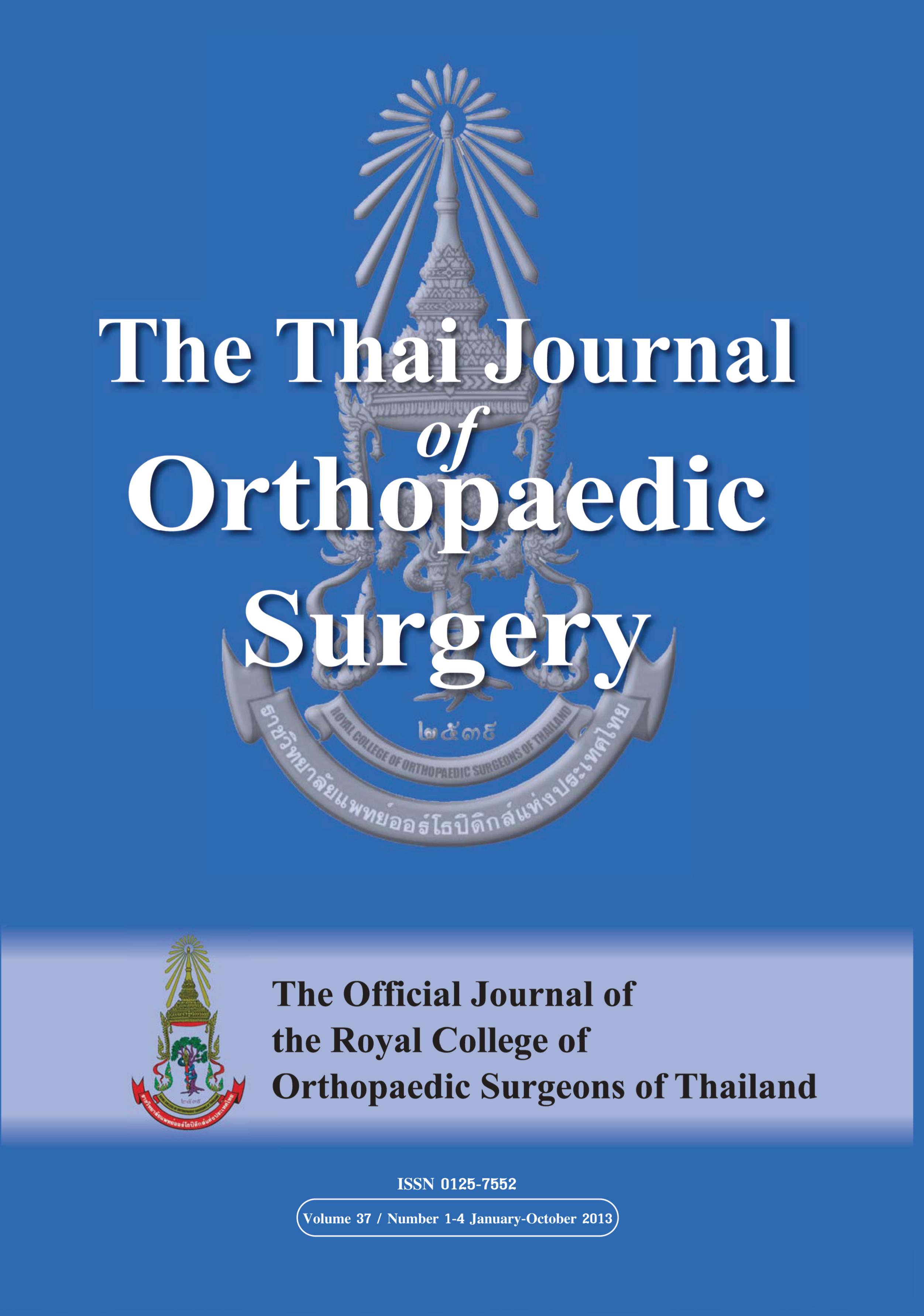การเปรียบเทียบผลการรักษากระดูกหน้าแข้งส่วนปลายหักด้วยวิธีการผ่าตัดเปิดแผลมาตรฐานกับการผ่าตัดเปิดแผลเล็ก
Main Article Content
บทคัดย่อ
วัตถุประสงค์: เปรียบเทียบผลการรักษาผู้ป่วยกระดูกหน้าแข้งส่วนปลายหักระหว่างวิธีการผ่าตัดเปิดแผลมาตรฐานกับวิธีการผ่าตัดเปิดแผลเล็ก
วิธีการศึกษา: ได้ทำการศึกษาแบบสุ่มตัวอย่างไปข้างหน้าโดยแบ่งผู้ป่วยกระดูกหน้าแข้งส่วนปลายหักทั้งแบบแผลปิดและแบบแผลเปิดระดับที่ 1 ออกเป็น 2 กลุ่ม โดยกลุ่มที่ 1 ใช้วิธีการผ่าตัดเปิดแผลมาตรฐาน และกลุ่มที่ 2 ใช้วิธีการผ่าตัดเปิดแผลเล็กโดยใช้อุปกรณ์ distal tibia locking plate ระยะเวลาการศึกษาตั้งแต่เดือนพฤษภาคม พ.ศ. 2554 ถึงเดือนกุมภาพันธ์ พ.ศ. 2556 ในโรงพยาบาลนครปฐมเปรียบเทียบในเรื่องของระยะเวลาในการผ่าตัด ระยะเวลาในการติดของกระดูก ผลแทรกซ้อนที่เกิดขึ้นและวัดผลลัพธ์ที่เกิดจากการใช้งานโดยอาศัย clinical rating system for the ankle ของ Teeny and Wiss criteria ที่ระยะเวลา 6 เดือนหลังการผ่าตัด
ผลการศึกษา: ศึกษาในผู้ป่วยทั้งหมด 36 รายแบ่งเป็นการผ่าตัดเปิดแผลมาตรฐาน 21 รายและการผ่าตัดเปิดแผลเล็ก 15 ราย พบว่าระยะเวลาการผ่าตัดของทั้งสองวิธีไม่มีความแตกต่างกัน (P=1.0) ระยะเวลาในการเชื่อมติดของกระดูกทางเอ็กซเรย์ของทั้งสองวิธีไม่มีความแตกต่างกัน (P=0.18) ผลลัพธ์จากการใช้งานจาก Teeny and Wiss criteria ของทั้งสองวิธีไม่มีความแตกต่างกัน (P=0.55) อัตราการติดเชื้อที่ผิวหนังของทั้งสองวิธีไม่มีความแตกต่างกัน (P=0.20) ผลจากการผ่าตัดทั้งสองวิธีไม่พบกระดูกติดผิดรูปและไม่พบกระดูกติดช้า
สรุป: การผ่าตัดเปิดแผลเล็กมีผลลัพธ์ไม่แตกต่างกันกับการผ่าตัดเปิดแผลมาตรฐานในการรักษาผู้ป่วยกระดูกหน้าแข้งส่วนปลายหัก
Article Details
เอกสารอ้างอิง
2. Marsh JL, Saltzman CL. Ankle fractures. In: Bucholz RW, Heckman JD, editor. Rockwood and green's fractures in adult V.2. 5th ed. Philadelphia: Lippincott Williams & Wilkins; 2001. p. 2001-90.
3. Gautier E, Ganz R. The biological plate osteosynthesis. Zentralbl Chir 1994; 119: 564-72.
4. Helfet DL. Suk M. Minimally invasive percutaneus plate osteosynthesis of fracture of the distal tibia. Instr Course Lect 2004; 53: 471-5.
5. Apivatthakakul T, Arpornchayanon O, Bavornratanavech S. Minimally invasive plate osteosynthesis (MIPO) of the humeral shaft fracture. Is it possible? A cadaveric study and preliminary report. Injury 2005; 36: 530-8.
6. Apivatthakakul T, Chiewcharntanakit S. Minimally invasive plate osteosynthesis (MIPO) in the treatment of the femoral shaft fracture where intrameddurary nailing is not indicated. Int Orthop 2009; 33: 1119-26.
7. Oh CW, Oh JK, Kyung HS, Jeon IH, Park BC, Min WK, et al. Double plating of unstable proximal tibial fractures using minimally invasive percutaneous osteosynthesis technique. Acta Orthop 2006; 77: 524-30.
8. Oh CW, Park BC, Kyung HS, Kim SJ, Kim HS, Lee SM, et al. Percutaneous plating for unstable tibial fractures. J Orthop Sci 2003; 8: 166-9.
9. Helfet DL, Shonnard PY, Levine D, Borrelli J Jr. Minimally invasive plate osteosynthesis of distal fractures of the tibia. Injury 1997; 28 Suppl 1: A42-7.
10. Apivattahakakul T, Khong S. Tibia KS, Shaft F. In: Tong G, Bavonratanavech S, editor. AO manual of fracture management. Minimally invasive plate osteosynthesis (MIPO). Concepts and cases presented by AO East Asia. Stuttgard New York: Georg Thieme Verlage; 2006. p. 208-302.
11. Bavonratanavech S. Instruments. In: Tong G, Bavornatanavech S, editors. AO manual of fracture management. Minimally invasive plate osteosynthesis (MIPO). Concepte and cesea presented by AO East Asia. Stuttgart New York: GeorgThieme Verlag; 2006. p. 20-9.
12. Teeny SM, Wiss DA. Open reduction and internal fixation of tibial plafond fractures. Variables contributing to poor results and complications. Clin Orthop Relat Res 1993; 292: 108-17.
13. Lee YS, Chen SH, Lin JC, Chen YO, Huang CR, Cheng CY. Surgical treatment of distal tibia fractures: a comparison of medial and lateral plating. Orthopedics 2009; 32: 163.
14. Robert WC. Principles of internal fixation. In: Bucholz RW, Heckman JD, editor. Rockwood and green's fractures in adults. 4th ed. Philadelphia: Lippincott Williams & Wilkins; 1996. p. 159-217.
15. Mahajan N. Minimally invasive techniques in Distal Tibial Fractures. JK Science 2008; 10: 78-80.
16. Webb J, Mc Murtry I, Port A, Liow R. Fractures of the distal tibia: Functional outcome following Minimally Invasive locking Plate Osteosynthesis. J Bone Joint Surg Br 2012; 94B: 90.


